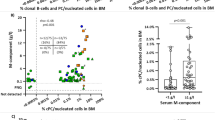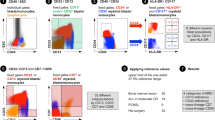Abstract
Multiparameter flow cytometry may be used to detect minimal residual disease in acute leukemia because leukemic cells often display aberrant phenotypes when compared to normal cells. One limitation of this approach in B-precursor ALL is that leukemic phenotypes are often qualitatively similar to normal marrow B progenitors, though it has long been recognized that the latter show a predictable pattern of antigen expression with differentiation. In this study we used four-color flow cytometry to define precisely the patterns of normal antigen expression on a series of normal bone marrows using two different four-color combinations of antibodies: CD19- APC/CD45-perCP/CD20-PE/CD10-FITC; and CD19-APC/CD45-perCP/CD9-PE/CD34-FITC. A series of dual parameter displays were created in which normal B precursors occupied predictable regions. We then tested these antibody combinations on a series of 82 cases of B-precursor ALL and found that in 76/82 cases (93%) the first combination demonstrated an abnormal population on at least one of the dual parameter displays, and that 72/77 cases tested (94%) showed an abnormality with the second combination. When taken together, 81/82 cases (99%) showed an abnormality. When purified blasts were serially diluted into normal marrows we found a sensitivity of detection of 1 cell in 104 normal marrow cells provided sufficient CD19+ cells were acquired to visualize the abnormal population as a discrete cluster. Because the pattern of antigen expression in normals is very reproducible, it is possible to create a fixed set of geometrical regions to define the normal; this makes analysis of an unknown sample very straightforward. We conclude that our approach could be employed as a simple method for the detection of minimal residual disease in B-precursor ALL, and unlike many other methods should prove applicable to virtually all cases of this malignancy.
This is a preview of subscription content, access via your institution
Access options
Subscribe to this journal
Receive 12 print issues and online access
$259.00 per year
only $21.58 per issue
Buy this article
- Purchase on Springer Link
- Instant access to full article PDF
Prices may be subject to local taxes which are calculated during checkout
Similar content being viewed by others
Author information
Authors and Affiliations
Rights and permissions
About this article
Cite this article
Weir, E., Cowan, K., LeBeau, P. et al. A limited antibody panel can distinguish B-precursor acute lymphoblastic leukemia from normal B precursors with four color flow cytometry: implications for residual disease detection. Leukemia 13, 558–567 (1999). https://doi.org/10.1038/sj.leu.2401364
Received:
Accepted:
Published:
Issue Date:
DOI: https://doi.org/10.1038/sj.leu.2401364
Keywords
This article is cited by
-
Minimal residual disease in acute lymphoblastic leukemia: optimal methods and clinical relevance, pitfalls and recent approaches
Medical Oncology (2014)
-
Monitoring MRD with flow cytometry: an effective method to predict relapse for ALL patients after allogeneic hematopoietic stem cell transplantation
Annals of Hematology (2012)
-
EuroFlow antibody panels for standardized n-dimensional flow cytometric immunophenotyping of normal, reactive and malignant leukocytes
Leukemia (2012)



